Potato variety Blue
Blueness is a medium late ripening potato variety (Solanum tuberosum). Bred by specialists of the All-Russian Scientific Research Institute of Potato Farming named after V.I. A.G. Lorkha. Obtained by crossing the hybrid 128-6 with the Gatchinsky variety. Included in the State Register of Breeding Achievements of the Russian Federation in 1993. Approved for use in four regions of Russia: North Caucasian (Republic of Adygea, Dagestan, Ingushetia, Kabardino-Balkarian, North Ossetia-Alania, Chechen, Crimea; Krasnodar and Stavropol Territories, Rostov Region), Central Black Earth (Voronezh, Kursk, Belgorod , Lipetsk, Oryol, Tambov regions), Volgo-Vyatsky (Kirov, Sverdlovsk and Nizhny Novgorod regions; Republics of Mari El, Udmutrt and Chuvash; Perm Territories) and Central (Ivanovo, Kaluga, Bryansk, Vladimir, Moscow, Ryazan, Smolensk and Tula regions ). Authors: L.N. Kukushkina, L.P. Rumyantseva, N.M. Fomina, N.I. Kukushkin, G.M.Sariev, B.A. Pisarev, N.P. Sklyarova, L.N. Trofimets, A.N. Rudnev.
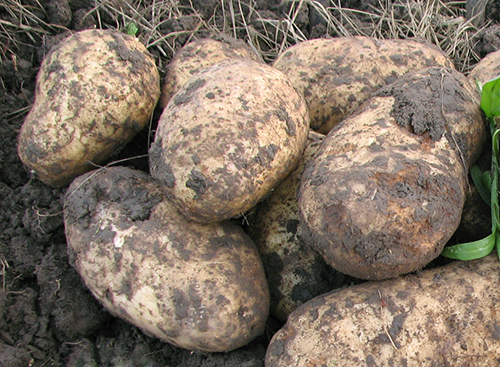
The ripening period, starting from the day of planting in the ground, is 90 - 110 days.
Plants are medium-sized, semi-erect. Leaves are dark green in color, medium in size, with a glossy surface. Flowering profuse, long, pale purple and blue flowers with white tips. This color of flowers gave the name to the variety.
A thicker landing is recommended (row spacing - 75 cm, in a row - after 25 cm). Seed material can be cut during planting. When planted early, when the soil has not yet warmed up enough, Blueness sprouts uncommonly, even if the seed potatoes are well sprouted.
Tubers are round-oval, medium and large in size, with a creamy pulp, weighing up to 150 grams. The peel is slightly mesh (rough), light beige in color. The eyes are superficial, wide, occurring at shallow and medium depths. The number of tubers in the nest is average (9 - 11 pieces). The yield of marketable tubers is 400 - 500 kg / ha. The mass of one marketable tuber is 90 - 110 grams. Marketability 91 - 95%.
It is advisable to dig out the Blueness at a later date. It is stored until spring (April - May) and does not germinate for a long time if properly kept in the cellar. Therefore, seed potatoes should be removed from storage early for germination.
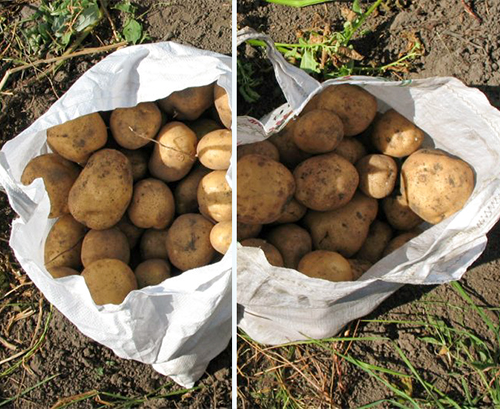
Table variety with excellent taste. Suitable for mashed potatoes, baking, boiling in a peeled and "uniform" form, as well as for processing into dry puree and starch. Starch content 17 - 19%. The tubers are well boiled, they crack during cooking, but do not completely disintegrate. The flesh of boiled potatoes is tender, moderately mealy, dry enough, very pleasant to the taste, does not darken during cooking.
This variety is characterized by resistance to drought, Y-virus, Alternaria, scab, Rhizoctonia, potato cancer (pathotype 1), ring and wet rot, but is susceptible to golden potato nematode. The susceptibility to late blight of tops and tubers is moderate. Gardeners also note that if there are other varieties on the site, then the Colorado potato beetle bypasses this potato.
Advantages of potatoes Blueness: high yield, keeping quality, good presentation, uniformity in size, drought resistance, excellent taste, disease resistance, decorative flowering.
The disadvantages include the problematic selection of seed material, tk. most tubers are large. Despite the fact that these potatoes are well adapted to dry conditions, the tubers are deformed in too hot summers. However, the yield remains high.In some years, with excessive soil moisture and sparse planting, hollowness is possible.
This is not the best variety for commercial use as it is has too late harvesting time and not the most advantageous form of tubers. It is ideal for hobbyist growers because has an excellent taste and does not degenerate for a long time.
It is believed that Blueness replaced the previously popular Sineglazka variety and has the best qualities of this potato.

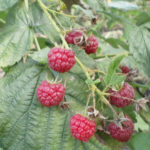
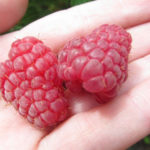

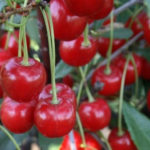
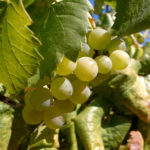



I tried it just as a replacement for Sineglazka (2014 - 2016). Yes, keeping quality is better, the yield is higher, the tubers are larger, but her taste is very far from Sineglazka. It takes longer to cook, is already falling apart, and the middle is still firm.
Blue suits me only due to the yield: there has not yet been such a year that it failed. Drought, constant rains, cold summers - it doesn't matter. Potatoes are always large, numerous, round in shape, grow heap, are taken out of the ground along with the tops. They are stored well, do not germinate for a long time. About the Colorado potato beetle - that's right, this variety is the last thing that he will like! The largest potatoes have voids inside. I only use Blue for mashed potatoes, because crumbles when cooking or frying. For planting tubers, due to their size, you have to pre-cut into several parts, sprinkle and dry.
I bought a potato variety Golubizna the year before last (in the fall) in the agrocenter. The seller promised that it was a super elite. I planted it on a level with all the potatoes in the same area with Azofoski feeding. The soil is loam and not every potato gives a good harvest for this. You have to act by trial and error.
I planted tubers in early May - the usual time for our region. It sprouted relatively smoothly. The bushes are medium in height and spreading, dark green.
By the end of August, the tops began to turn black and yellow and were cut off. I dug it at the end of August. The result for the first year was relatively good (taking into account the past summer and the quality of the seed tubers). In one bush there were several (5 - 8) round and slightly elongated potatoes of medium size and slightly larger than average, as well as several small ones. But not in all bushes. There were also unsuccessful ones. I blame the quality of the seed - they were pretty crumpled during delivery.
The potatoes tasted delicious. The only pity is that the pulp is not yellow, but beige. But also not white - which is already good.
The next year, I set aside high-quality seed material for sowing. Hope it doesn't let you down!